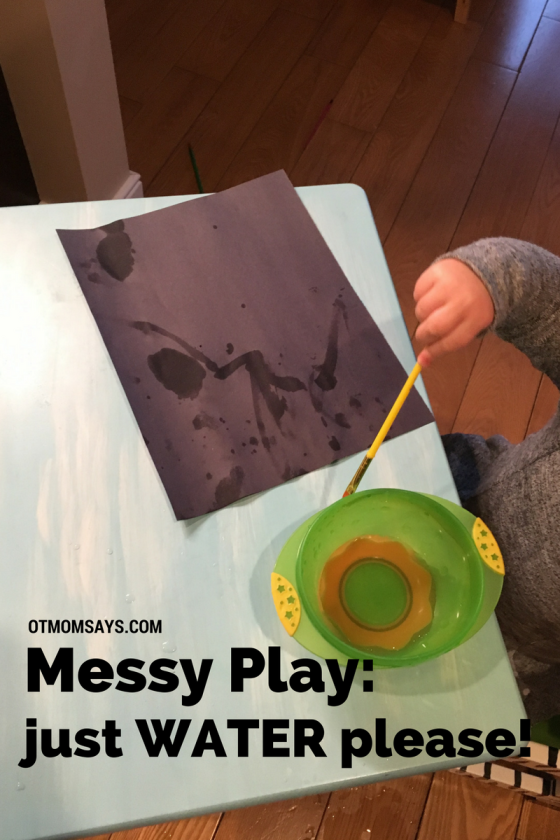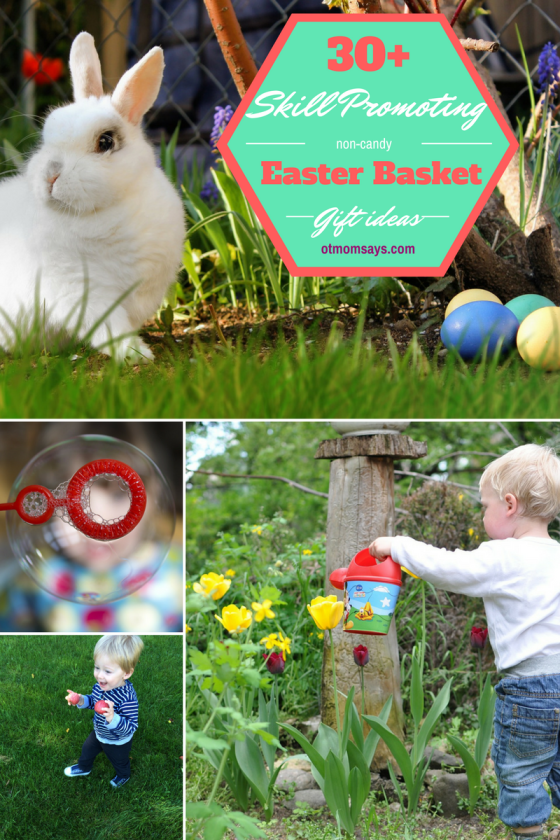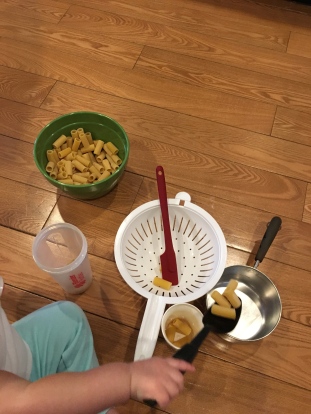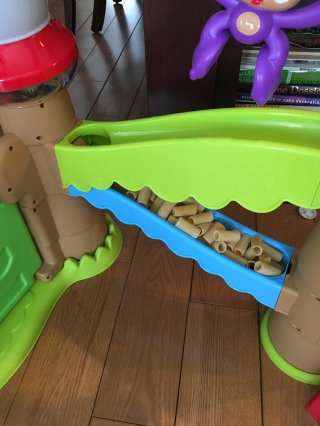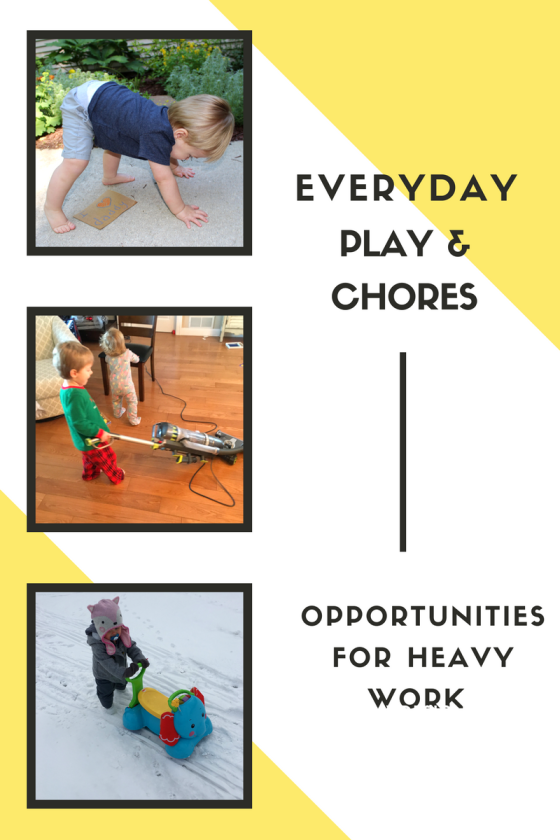Dr. Dad says, “I’ll rock the baby tonight.”
OT Mom says, “Well then, good night to the both of you.”
Like many parents, he often falls asleep while rocking her, but why? Not only are our babies warm and snuggly, (and most of us are usually at least a little short on sleep), there’s more going on. It’s the rocking. The slow, linear movement of rocking has a direct calming effect on both of them, thanks to their vestibular systems.

Many of us are familiar with the five senses we learned about as kids, but there are several additional senses that have a ton of impact on just about everything we do. In a post a couple weeks ago, I provided some information about the proprioceptive system. Another super important system (that works very closely with the proprioceptive system) is the vestibular system.
So what is the vestibular sense? It’s the sense of where your head is positioned relative to gravity and your awareness of head movements. It works closely with our visual and proprioceptive systems to allow for us to maintain balance. The receptors for this sense are located in the inner ear and include three semicircular canals filled with fluid and hairs, and two organ sacs filled with gel, hairs, and little rock-like things called otoconia8. I will spare you the physiological details, but pretty much the hairs move in response to movement, movement momentums, and the position of your head in space.
When I hear the someone say, they’re “losing their marbles,” I really hope they don’t mean their otoconia. There is actually a disorder known as Benign Paroxysmal Positional Vertigo (BPPV) where those silly otoconia are displaced into one of the semi-circular canals causing symptoms like vertigo, nausea, and poor balance8.

Dr. dad tells his patients that “they’ve got rocks loose in their heads,” and they laugh.
When we engage in motion that is slow, rhythmic, and linear, it has a calming effect on our nervous system4. That’s why things like rocking babies or swaying with them slowly, puts them to sleep (and sometimes makes the moms and dads tired too). The vestibular system also contributes to the drowsiness we get in the car. It’s the constant linear motion that creates a calming effect. When used in a different way, this system can be very alerting. When movement is fast, irregular (such as sudden starts and stops), or changing directions and intensities, it stimulates our nervous system and heightens our awareness and alertness4,16.

But what about car sickness? I blame Dr. Dad’s bad driving. Just kidding (kind of). Actually, car sickness is due to the visual and vestibular systems getting contradictory information8– that’s why it’s more common for people when they try to read in the car. If you’re focused on something in front of you, and your visual system is not getting input of the movement of driving down the street, but your inner ear is, it’s a disconnect and your nervous systems says, “somethings not quite right here, let’s vomit.” Well, hopefully you’re not to the point of vomiting, but you get my drift. That’s also why when you are in the front seat, especially the driver, you’re less prone to car sickness as you’re more aware (I hope especially if you are the driver) of the movements of the car and yourself.

This nausea can also happen if you are sitting still but you’re getting visual input telling your brain that you are moving, such as in some 3D experiences or movies with a shaky camera. I have a distinct memory of my sister listening to, rather than watching, the end of one such shaky camera horror movie with her face over an empty popcorn bowl. The visual to vestibular disconnect made her that unable to watch.
Usually, however, for most of us the vestibular system functions well with our other senses to do amazing things. In our brain, vestibular information meets up in a central hub that also receives information about proprioception (relating to joint movements and positions), vision, tactile (touch), and auditory information. This allows for:
- control of our head movements
- stabilization and control our eye movements (even when our heads are moving)
- maintaining and adjusting body posture and influencing our body’s muscle tone
- development of self regulation and sensory awareness
- engagement in bilateral integration (using both sides of the body efficiently, such as both hands together to complete a task).
- auditory language development2,4,8,9,10

As you can see, the vestibular system is linked to many, many areas of the brain and has a wide spread influence over brain organization and functioning. There’s also some research suggesting that vestibular input can influence stress reduction13, emotional behavior6,12 and mood11,16. In some settings, vestibular input has been shown to promote academic participation and achievement15.

For the kids of the world, it’s so important to provide them with opportunities to develop and strengthen this system. There’s evidence that an environment rich with vestibular-proprioceptive opportunities has powerful effects on development14. It baffles me to see school districts cutting back on recess, PE and related activities. In this day and age of technology, our kids still need to MOVE!
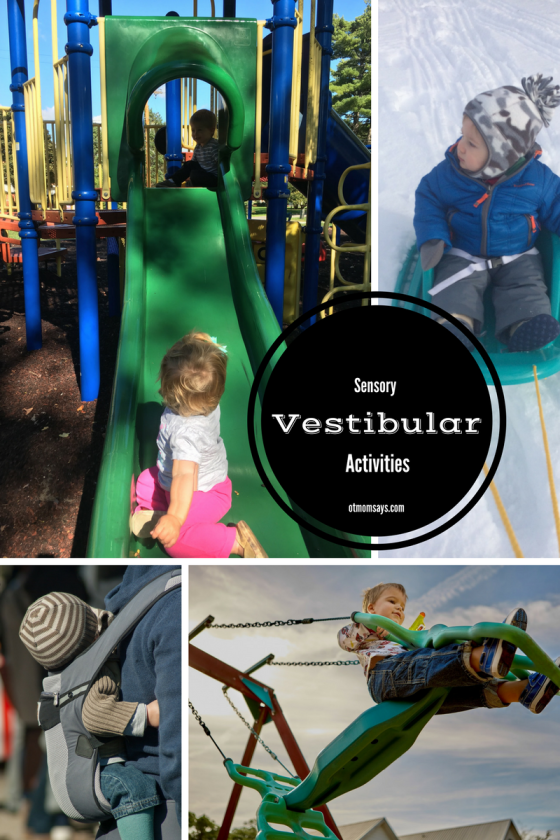
So, now that we know a little about this incredible sensory system, let’s use this knowledge to brainstorm some fun vestibular activities that could promote good things today!
-In your house, equipment free– to provide stimulating input you can spin, dance roll, climb exercise, run with lots of stop and go’s (think red light/green light).
-Play outside- swings, slides, bike riding (always wear a helmet), wagon rides, scooter boards, push cars, sledding, skiing, running, playing team sports, and the list could go on and on.
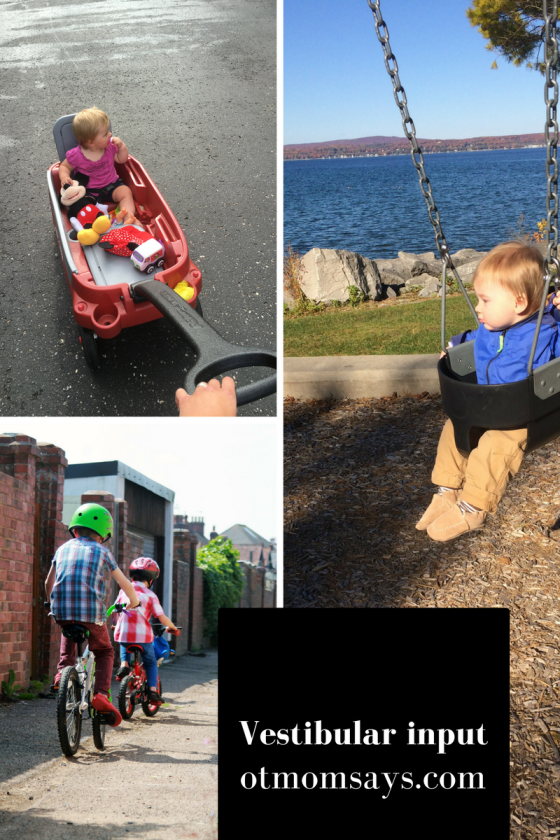
– Try similar things inside- my kids love pushing each other in a cardboard box and spinning each other on our swivel chairs and office chairs for increased stimulation; try rhythmic, slow rocking for a calming effect.
– Tai Chi- While I have not tried this personally, there is more and more evidence that engaging in Tai Chi can improve balance, well-being, strength, and potentially decreases falls for older individuals1,7.
– Dance- Try slow dancing to relax, or dance fast and wild to wake up. There’s research on the benefits of dance for older adults too, with improvements found in both cognitive and sensorimotor performance5.
– Wear your baby– instead of just rocking your baby, you can use a baby wrap, carrier, or baby backpack to attach your baby to you while you grocery shop, clean your house, or go for a walk. I’ve even taking my kids morel mushroom hunting using them. Not only does your child get the wonderful movement, I think it’s also great for bonding and allowing them to be involved in your daily activities.
– Ride a horse- there’s a whole branch of therapy known as hippotherapy where horses are utilized as a treatment tool for OTs, PTs, and SLPs. Riding a horse provides vestibular and proprioceptive input and can promote improvements in balance, strength, coordination, mobility, balance, sensory motor function, postural control, attention, mobility, and communication3.
-If you’re prone to motion sickness, don’t read in the car. In fact try to pay attention ahead out the window to reinforce the connect between your visual and vestibular systems so that you don’t get the negative effect from a disconnect.

It is important to remember that each individual has different thresholds for sensory input for each individual sensory system. For example, my kids have pretty high thresholds for vestibular input, as they love to spin, go on slides, and move constantly. They love spinning each other in our gliding chairs, and often my son wants to spin me while I’m sitting with my daughter. I always end up limiting the repetitions as my threshold for rotary movement is low. I get nauseous easily and am prone to motion sickness on boats and in cars. You can also think about our individual differences when considering how people differ in regards to roller coasters. Some people love the thrill of the motion and tolerate spinning upside down, while others you will find wanting to puke in the corner after just the thought of it.

Additionally, there is also something known as gravitation insecurity, which makes some children very fearful and anxious in situations where their feet leave the ground6. I mentioned a lot about the autonomic effects that can come with waking up this system, so please use caution. If you do any of these activities on a regular basis or decide to try a new one, be aware of a few warning signs that you’re overdoing it: pallor, nausea, changes in heart rate and breathing, palpitations, anxiety. Please take things slow and do what works for you. Always contact a doctor or certified therapist to address individual issues.
*Disclaimer: The information presented in the blog is intended for information and entertainment purposes only. Please consult your physician with any medical concerns and/or for medical advice. The information presented is not intended to be used in place of individualized therapy services, please contact your health care team for skilled therapy if you think it is necessary. Please supervise your children (or friends, spouses, etc) if you decide to try any of the activities or ideas presented as the author or this blog does not claim liability for possible injury or negative consequences related to the activities and ideas presented here.
Resources
1. Adler, P. A., & Roberts, B. L. (2006). The use of tai chi to improve health in older adults. Orthopaedic Nursing, 25(2), 122-6. Retrieved from https://search.proquest.com/docview/195963159?accountid=143111
2. An, S. L. (2015). The effects of vestibular stimulation on a child with hypotonic cerebral palsy. Journal of Physical Therapy Science, 27(4), 1279-1282. doi:http://dx.doi.org/10.1589/jpts.27.1279
3. Bender, M., & McKenzie, S. (2008, Winter). Hippotherapy. Palaestra, 24, 43-44. Retrieved from https://search.proquest.com/docview/213181696?accountid=143111
4. Kramer, P. & Hinojosa, J. (2010) Frames of Reference for Pediatric Occupational Therapy (3rd). Lippincott Williams & Wilkins, Philadelphia, PA
5. Kshtriya, S., Barnstaple, R., Rabinovich, D., Desouza, J. F., & X. (2015). Dance and aging: A critical review of findings in neuroscience. American Journal of Dance Therapy, 37(2), 81-112. doi:http://dx.doi.org/10.1007/s10465-015-9196-7
6. Lane, Shelly J, PHD,O.T.R./L., F.A.O.T.A., Lynn, J. Z., & Reynolds, Stacey,P.H.D., O.T.R./L. (2010). Sensory modulation: A neuroscience and behavioral overview. OT Practice, 15(21), CE1-CE8. Retrieved from https://search.proquest.com/docview/807980071?accountid=143111
7. Leung, D. P. K., M.Sc, Chan, C. K. L., M.Sc, Tsang, H. W. H., PhD., Tsang, W. W. N., PhD., & Jones, A. Y. M., PhD. (2011). Tai chi as an intervention to improve balance and reduce falls in older adults: A systematic and meta-analytical review. Alternative Therapies in Health and Medicine, 17(1), 40-8. Retrieved from https://search.proquest.com/docview/851708686?accountid=143111
8. Lundy-Ekman, L. (2007). Neuroscience: Fundamentals for Rehabilitation (3rd). Saunders Elsevier, St. Louis, Missouri
9. Mauer, D. M. (1999). Issues and applications of sensory integration theory and treatment with children with language disorders. Language, Speech & Hearing Services in Schools, 30(4), 383. Retrieved from https://search.proquest.com/docview/232585154?accountid=143111
10. McHugh Pendleton, H. & Schultz-Krohn, W. (2006). Pedretti’s Occupational Therapy: Practice Skills for Physical Dysfunction (6th). Mosby Elsevier, St. Louis, Missouri
11. Mehta, Z., & Stakiw, D. B. (2004). Childhood vestibular disorders: A tutorial. Communication Disorders Quarterly, 26(1), 5-16,56-57. Retrieved from https://search.proquest.com/docview/213789303?accountid=143111
12. Rajagopalan, A., Jinu, K. V., Sailesh, K. S., Mishra, S., Reddy, U. K., & Mukkadan, J. K. (2017). Understanding the links between vestibular and limbic systems regulating emotions. Journal of Natural Science, Biology, and Medicine, 8(1), 11-15. doi:http://dx.doi.org/10.4103/0976-9668.198350
13. Sailesh, K. S., & Mukkadan, J. K. (2015). Controlled vestibular stimulation, standardization of A physiological method to release stress in college students. Indian Journal of Physiology and Pharmacology, 59(4), 436-441. Retrieved from https://search.proquest.com/docview/1812437841?accountid=143111
14. Schaaf, Roseann C, PHD,O.T.R./L., F.A.O.T.A., & Lane, Shelly J, PHD,O.T.R./L., F.A.O.T.A. (2009). Neuroscience foundations of vestibular, proprioceptive, and tactile sensory strategies. OT Practice, 14(22), CE1-CE8. Retrieved from https://search.proquest.com/docview/232422301?accountid=143111
15. Watling, R., & Hauer, S. (2015). Effectiveness of ayres sensory integration® and sensory-based interventions for people with autism spectrum disorder: A systematic review. The American Journal of Occupational Therapy, 69(5), 1-8A. Retrieved from https://search.proquest.com/docview/1711617297?accountid=143111
16. Winter, L., Wollmer, M. A., Laurens, J., Straumann, D., & Kruger, T. H. C. (2013). Cox’s chair revisited: Can spinning alter mood states? Frontiers in Psychiatry, 4, 132. doi:http://dx.doi.org/10.3389/fpsyt.2013.00132


















